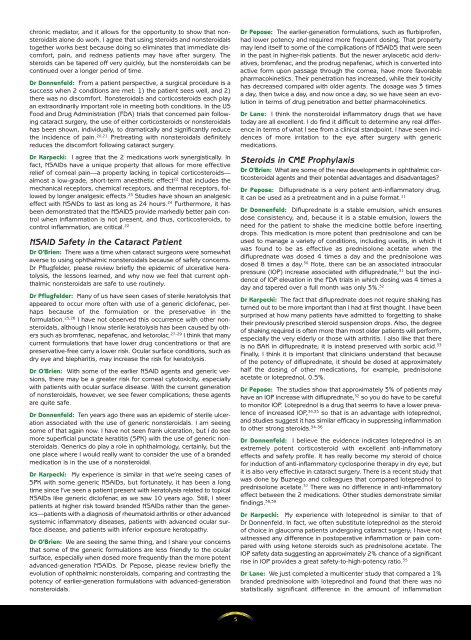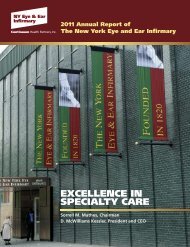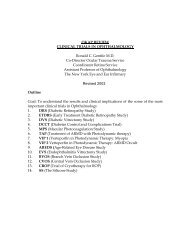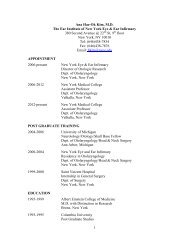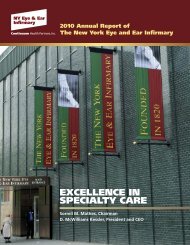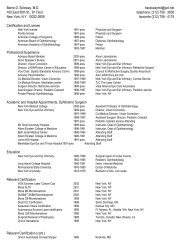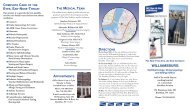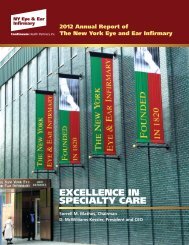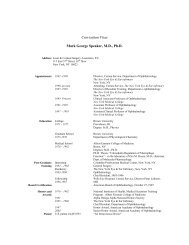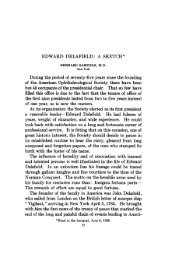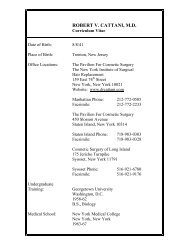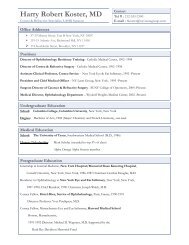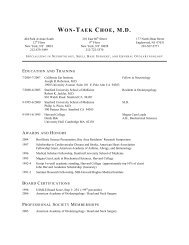Prevention and Management of Ocular Inflammation - New York Eye ...
Prevention and Management of Ocular Inflammation - New York Eye ...
Prevention and Management of Ocular Inflammation - New York Eye ...
You also want an ePaper? Increase the reach of your titles
YUMPU automatically turns print PDFs into web optimized ePapers that Google loves.
chronic mediator, <strong>and</strong> it allows for the opportunity to show that non -<br />
steroidals alone do work. I agree that using steroids <strong>and</strong> nonsteroidals<br />
together works best because doing so eliminates that immediate discomfort,<br />
pain, <strong>and</strong> redness patients may have after surgery. The<br />
steroids can be tapered <strong>of</strong>f very quickly, but the nonsteroidals can be<br />
continued over a longer period <strong>of</strong> time.<br />
Dr Donnenfeld: From a patient perspective, a surgical procedure is a<br />
success when 2 conditions are met: 1) the patient sees well, <strong>and</strong> 2)<br />
there was no discomfort. Nonsteroidals <strong>and</strong> corticosteroids each play<br />
an extraordinarily important role in meeting both conditions. In the US<br />
Food <strong>and</strong> Drug Administration (FDA) trials that concerned pain following<br />
cataract surgery, the use <strong>of</strong> either corticosteroids or nonsteroidals<br />
has been shown, individually, to dramatically <strong>and</strong> significantly reduce<br />
the incidence <strong>of</strong> pain. 20,21 Pretreating with nonsteroidals definitely<br />
reduces the discomfort following cataract surgery.<br />
Dr Karpecki: I agree that the 2 medications work synergistically. In<br />
fact, NSAIDs have a unique property that allows for more effective<br />
relief <strong>of</strong> corneal pain—a property lacking in topical corticosteroids—<br />
almost a low-grade, short-term anesthetic effect 22 that includes the<br />
mechanical receptors, chemical receptors, <strong>and</strong> thermal receptors, followed<br />
by longer analgesic effects. 23 Studies have shown an analgesic<br />
effect with NSAIDs to last as long as 24 hours. 24 Furthermore, it has<br />
been demonstrated that the NSAIDS provide markedly better pain control<br />
when inflammation is not present, <strong>and</strong> thus, corticosteroids, to<br />
control inflammation, are critical. 22<br />
NSAID Safety in the Cataract Patient<br />
Dr O’Brien: There was a time when cataract surgeons were somewhat<br />
averse to using ophthalmic nonsteroidals because <strong>of</strong> safety concerns.<br />
Dr Pflugfelder, please review briefly the epidemic <strong>of</strong> ulcerative keratolysis,<br />
the lessons learned, <strong>and</strong> why now we feel that current ophthalmic<br />
nonsteroidals are safe to use routinely.<br />
Dr Pflugfelder: Many <strong>of</strong> us have seen cases <strong>of</strong> sterile keratolysis that<br />
appeared to occur more <strong>of</strong>ten with use <strong>of</strong> a generic dicl<strong>of</strong>enac, perhaps<br />
because <strong>of</strong> the formulation or the preservative in the<br />
formulation. 25,26 I have not observed this occurrence with other non -<br />
steroidals, although I know sterile keratolysis has been caused by others<br />
such as bromfenac, nepafenac, <strong>and</strong> ketorolac. 27–29 I think that many<br />
current formulations that have lower drug concentrations or that are<br />
preservative-free carry a lower risk. <strong>Ocular</strong> surface conditions, such as<br />
dry eye <strong>and</strong> blepharitis, may increase the risk for keratolysis.<br />
Dr O’Brien: With some <strong>of</strong> the earlier NSAID agents <strong>and</strong> generic versions,<br />
there may be a greater risk for corneal cytotoxicity, especially<br />
with patients with ocular surface disease. With the current generation<br />
<strong>of</strong> nonsteroidals, however, we see fewer complications; these agents<br />
are quite safe.<br />
Dr Donnenfeld: Ten years ago there was an epidemic <strong>of</strong> sterile ulceration<br />
associated with the use <strong>of</strong> generic nonsteroidals. I am seeing<br />
some <strong>of</strong> that again now. I have not seen frank ulceration, but I do see<br />
more superficial punctate keratitis (SPK) with the use <strong>of</strong> generic nonsteroidals.<br />
Generics do play a role in ophthalmology, certainly, but the<br />
one place where I would really want to consider the use <strong>of</strong> a br<strong>and</strong>ed<br />
medication is in the use <strong>of</strong> a nonsteroidal.<br />
Dr Karpecki: My experience is similar in that we’re seeing cases <strong>of</strong><br />
SPK with some generic NSAIDs, but fortunately, it has been a long<br />
time since I’ve seen a patient present with keratolysis related to topical<br />
NSAIDs like generic dicl<strong>of</strong>enac as we saw 10 years ago. Still, I steer<br />
patients at higher risk toward br<strong>and</strong>ed NSAIDs rather than the generics—patients<br />
with a diagnosis <strong>of</strong> rheumatoid arthritis or other advanced<br />
systemic inflammatory diseases, patients with advanced ocular surface<br />
disease, <strong>and</strong> patients with inferior exposure keratopathy.<br />
Dr O’Brien: We are seeing the same thing, <strong>and</strong> I share your concerns<br />
that some <strong>of</strong> the generic formulations are less friendly to the ocular<br />
surface, especially when dosed more frequently than the more potent<br />
advanced-generation NSAIDs. Dr Pepose, please review briefly the<br />
evolution <strong>of</strong> ophthalmic nonsteroidals, comparing <strong>and</strong> contrasting the<br />
potency <strong>of</strong> earlier-generation formulations with advanced-generation<br />
nonsteroidals.<br />
Dr Pepose: The earlier-generation formulations, such as flurbipr<strong>of</strong>en,<br />
had lower potency <strong>and</strong> required more frequent dosing. That property<br />
may lend itself to some <strong>of</strong> the complications <strong>of</strong> NSAIDS that were seen<br />
in the past in higher-risk patients. But the newer arylacetic acid derivatives,<br />
bromfenac, <strong>and</strong> the prodrug nepafenac, which is converted into<br />
active form upon passage through the cornea, have more favorable<br />
pharmacokinetics. Their penetration has increased, while their toxicity<br />
has decreased compared with older agents. The dosage was 3 times<br />
a day, then twice a day, <strong>and</strong> now once a day, so we have seen an evolution<br />
in terms <strong>of</strong> drug penetration <strong>and</strong> better pharmacokinetics.<br />
Dr Lane: I think the nonsteroidal inflammatory drugs that we have<br />
today are all excellent. I do find it difficult to determine any real difference<br />
in terms <strong>of</strong> what I see from a clinical st<strong>and</strong>point. I have seen incidences<br />
<strong>of</strong> more irritation to the eye after surgery with generic<br />
medications.<br />
Steroids in CME Prophylaxis<br />
Dr O’Brien: What are some <strong>of</strong> the new developments in ophthalmic corticosteroidal<br />
agents <strong>and</strong> their potential advantages <strong>and</strong> disadvantages?<br />
Dr Pepose: Difluprednate is a very potent anti-inflammatory drug.<br />
It can be used as a pretreatment <strong>and</strong> in a pulse format. 11<br />
Dr Donnenfeld: Difluprednate is a stable emulsion, which ensures<br />
dose consistency, <strong>and</strong>, because it is a stable emulsion, lowers the<br />
need for the patient to shake the medicine bottle before inserting<br />
drops. This medication is more potent than prednisolone <strong>and</strong> can be<br />
used to manage a variety <strong>of</strong> conditions, including uveitis, in which it<br />
was found to be as effective as prednisolone acetate when the<br />
difluprednate was dosed 4 times a day <strong>and</strong> the prednisolone was<br />
dosed 8 times a day. 30 Note, there can be an associated intraocular<br />
pressure (IOP) increase associated with difluprednate, 31 but the incidence<br />
<strong>of</strong> IOP elevation in the FDA trials in which dosing was 4 times a<br />
day <strong>and</strong> tapered over a full month was only 3%. 32<br />
Dr Karpecki: The fact that difluprednate does not require shaking has<br />
turned out to be more important than I had at first thought. I have been<br />
surprised at how many patients have admitted to forgetting to shake<br />
their previously prescribed steroid suspension drops. Also, the degree<br />
<strong>of</strong> shaking required is <strong>of</strong>ten more than most older patients will perform,<br />
especially the very elderly or those with arthritis. I also like that there<br />
is no BAK in difluprednate; it is instead preserved with sorbic acid. 33<br />
Finally, I think it is important that clinicians underst<strong>and</strong> that because<br />
<strong>of</strong> the potency <strong>of</strong> difluprednate, it should be dosed at approximately<br />
half the dosing <strong>of</strong> other medications, for example, prednisolone<br />
acetate or loteprednol, 0.5%.<br />
Dr Pepose: The studies show that approximately 3% <strong>of</strong> patients may<br />
have an IOP increase with difluprednate, 32 so you do have to be careful<br />
to monitor IOP. Loteprednol is a drug that seems to have a lower prevalence<br />
<strong>of</strong> increased IOP, 34,35 so that is an advantage with loteprednol,<br />
<strong>and</strong> studies suggest it has similar efficacy in suppressing inflammation<br />
to other strong steroids. 34–36<br />
Dr Donnenfeld: I believe the evidence indicates loteprednol is an<br />
extremely potent corticosteroid with excellent anti-inflammatory<br />
effects <strong>and</strong> safety pr<strong>of</strong>ile. It has really become my steroid <strong>of</strong> choice<br />
for induction <strong>of</strong> anti-inflammatory cyclosporine therapy in dry eye, but<br />
it is also very effective in cataract surgery. There is a recent study that<br />
was done by Buznego <strong>and</strong> colleagues that compared loteprednol to<br />
prednisolone acetate. 37 There was no difference in anti-inflammatory<br />
effect between the 2 medications. Other studies demonstrate similar<br />
findings. 38,39<br />
Dr Karpecki: My experience with loteprednol is similar to that <strong>of</strong><br />
Dr Donnenfeld. In fact, we <strong>of</strong>ten substitute loteprednol as the steroid<br />
<strong>of</strong> choice in glaucoma patients undergoing cataract surgery; I have not<br />
witnessed any difference in postoperative inflammation or pain compared<br />
with using ketone steroids such as prednisolone acetate. The<br />
IOP safety data suggesting an approximately 2% chance <strong>of</strong> a significant<br />
rise in IOP provides a great safety-to-high-potency ratio. 35<br />
Dr Lane: We just completed a multicenter study that compared a 1%<br />
br<strong>and</strong>ed prednisolone with loteprednol <strong>and</strong> found that there was no<br />
statistically significant difference in the amount <strong>of</strong> inflammation<br />
5


